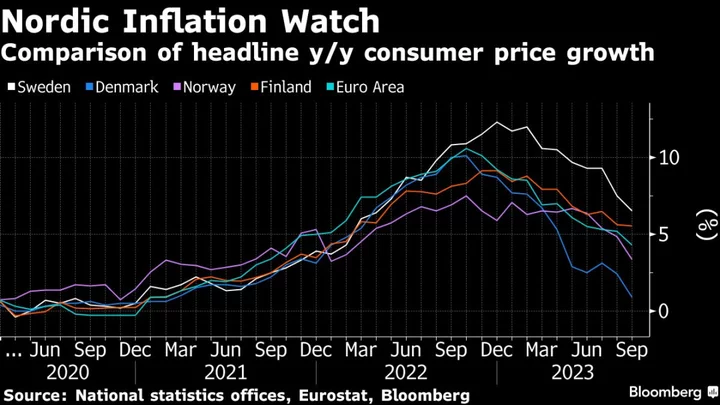Sweden’s core inflation rate declined less than expected in September, adding to arguments in favor of a final rate hike from the country’s central bank next month.
Prices excluding energy and interest-rate changes rose by 6.9% from a year earlier, a release from Statistics Sweden showed Friday. That was higher than the 6.7% expected by economists in a Bloomberg survey as well as the 6.6% pace the Riksbank had projected.
Before the release, economists were divided on whether the Riksbank is done hiking or if it will take its benchmark rate a quarter of a percentage point higher, to 4.25%, at its meeting on Nov. 22. Expectations for long-term inflation rates were unchanged in the latest Prospera survey of money market participants published on Thursday, while outlook for shorter-term rates declined.
“This strengthens our forecast for Riksbank hike in November, but the cooling inflation trend and yesterday’s easing Prospera keeps unchanged policy rate in play,” Svenska Handelsbanken AB’s economist Johan Lof said.
While borrowing costs may be nearing a peak, the central bank remains concerned about rapid price increases on services.
At their gathering last month, the Riksbank’s executive board members signaled that they may have to tighten more as inflationary pressures remain too high and a weak Swedish currency makes imported goods more expensive.
The krona strengthened after the inflation print was published, trading 0.4% higher at 11.5395 versus the euro as of 9:07 a.m. in Stockholm. The currency has recovered some ground after the Riksbank started selling a part of its dollar and euro reserves in an effort to avoid losses should the krona strengthen.
Read More: Riksbank’s Krona Lifeline Has Traders Guessing if Gains Can Stay
In September, the CPIF inflation rate that the Riksbank targets fell to 4% from 4.7% in the previous month, as electricity prices were 45% lower than a year ago. The central bank expects CPIF to stabilize near its 2% target in the second half of next year.
What Bloomberg Economics Says...
“Sweden’s higher-than-expected inflation print is a disappointment for the Riksbank. We see the central bank keeping its policy rate on hold at 4% when it meets next in November, but risks have now tilted upwards.”
—Selva Bahar Baziki, economist
The data comes after statistics elsewhere in the Nordic region showed price increases slowing more than expected. The drop in Norway’s core inflation rate has increased expectations that Norges Bank may choose to keep its benchmark rate at 4.25% through the end of this year.
--With assistance from Joel Rinneby.
(Adds chart, details on krona, Bloomberg Economics comment.)

